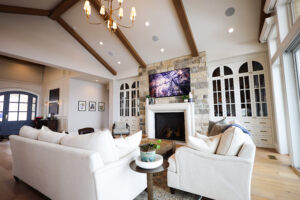These days, you don’t need a massive living room to enjoy a true home theater experience. With the right setup and a little creativity, even small rooms can be transformed into incredible spaces for watching movies, shows, and sports.
In this blog, we’ll guide you through how to make the most of a small space to create the perfect home theater. Whether you’re a passionate movie buff or simply looking to upgrade family movie nights, we’ve got you covered. We’ll share design ideas, smart technology options, and practical installation tips to help you turn almost any room – whether it’s a spare bedroom, basement nook, or cozy den into a comfortable, immersive entertainment zone.
Understanding the Basics of Small Home Theater Design
When you’re designing a home theater for a small room, there are a few important things to keep in mind.
You’ll need to consider what display type best compliments your small home theater. From smart TVs to projectors, something is out there to fit your needs. Consider how much natural light enters the room and choose a display type that will still provide good image quality in different lighting conditions.
If you plan to set up a home theater that looks and feels professional, lighting should be one of your top priorities. Proper lighting can enhance the viewing experience and create a cozy atmosphere.
Sound quality is also an important factor. In small rooms, sound can easily bounce off walls and create echoes, so choosing the right speakers and positioning them properly is important. Wall-mounted speakers or in-ceiling speakers.
Lastly, the layout and seating – keep in mind the number of people you want to accommodate and choose seating that is comfortable and space-efficient, allowing everyone to enjoy the movie without feeling cramped.
In the following sections, we’ll explain how these factors contribute to a successful small home theater design. We’ll also provide tips and ideas to help you create the perfect movie-watching environment in your home.
Display Options for Your Small Theater Room
When choosing a small theater room display, the most popular options are Smart TVs and projectors. Both have their advantages, and it ultimately depends on personal preference.
Smart TVs are a great option for small spaces as they do not require any additional equipment or installation. There are many different options, such as OLED, LED, and QLED displays, each with its own features and price points.
Projectors offer a larger screen size, which can enhance the viewing experience, especially for movie enthusiasts. Sony projectors are our top pick for home theaters due to their high-quality image and color accuracy. However, projectors require additional equipment and installation, which may not be possible for every small theater room setup.
One way to combat space limitations is using a short-throw projector. These devices can be mounted on the wall or ceiling above the screen, projecting the image straight down. This setup saves space and gives you a cinema-like experience with a big screen. Another way to position a short-throw projector is to use a special cabinet placed below the screen. The projector stays inside the cabinet and projects the image upward onto the screen. These cabinets come in various designs, adding a touch of style to your home theater.
Whether you choose a projector or TV screen for your small home theater, you’ll need to consider the viewing distance to determine the correct size for your room. A screen that is too big can cause eye strain or other issues while watching a movie. Consult with a professional or use an online calculator to determine the optimal screen size for your space.
As another tip, the Kaleidescape platform offers top-notch streaming designed for home theaters. This platform is ideal for those who want to experience the same movie quality as a theater from the comfort of their home.
Smart Lighting Ideas for a Small Smart Theater
If you have a small theater room, it’s important to carefully consider the lighting to enhance your viewing experience.
Ambient Lighting: This type of lighting is used to create a comfortable atmosphere in the room and can be dimmed or changed based on preference. It’s best to have ambient lighting that can be adjusted rather than bright overhead lights that cannot be dimmed.
Task Lighting: Task lighting is used for specific activities, such as reading a book while a movie is on. These lights should be strategically placed around the room to avoid glare on the screen while giving you enough light to do your task. This can be challenging in a small space, and we recommend consulting a lighting professional to get the best results.
Accent Lighting: By placing fixtures to illuminate key features or artwork in the room, you can add depth and dimension, making a small space feel larger and more immersive. For example, light strips along the baseboards or spotlights can accentuate the room’s design and provide just enough light to navigate the dark without disrupting the movie.
Backlighting: Backlighting helps reduce eye strain during extended viewing sessions by maintaining a balance between the screen’s brightness and the surrounding environment. Plus, it can enhance the perceived contrast on the screen, making colors appear more vivid and images more detailed.
Sound Design: Make The Most Out of Your Small Home Theater
When it comes to sound design in a compact home theater, it’s important to pick a system that can give you an immersive audio experience without taking up too much space.
Some of the best options for small theaters are in-wall, in-ceiling, and hidden speakers. These specialized speakers are designed to blend seamlessly into your room’s decor, maintaining the aesthetic appeal without compromising audio quality. A great option for these types of speakers is Dolby Atmos. These speakers create a three-dimensional soundscape, making you feel like you’re right in the middle of the action. It is designed to project sounds in a way that makes it seem like they are coming from all directions, including overhead. This technology allows for a more immersive and realistic cinematic experience, enhancing every whisper, footstep, or explosion with remarkable clarity and depth.
Regardless of the type you choose, these speakers can be paired with sound-proofing panels to minimize echo and enhance audio clarity in small rooms. These can be placed behind speakers or on walls to create a more balanced and immersive sound experience. This may require the assistance of a professional installer who can optimize your audio setup for the best possible sound.
Layout and Seating Ideas
When planning the layout and seating for your small home theater, consider the following:
- The size of your room: Measure your room carefully before purchasing any furniture or equipment. This will help you determine how many seats can fit comfortably in the space and what size screen will work best.
- Tiered seating arrangements: Consider tiered seating to maximize the number of seats in a small room. This involves having multiple levels of seating, with the back rows raised slightly higher than the front. This ensures that everyone has a clear view of the screen.
- Multifunctional furniture: Choose furniture pieces that can serve multiple purposes, such as storage ottomans or recliners with built-in cup holders and storage compartments. This will help save space and keep the room clutter-free. Opt for darker colors to reduce glare on the screen.
- Distance between seats: Allow enough space between seats to ensure comfort and easy movement within the room.
Lastly, ensure there’s enough space for navigation and that the room is free of clutter. A small room can quickly feel cramped, so it’s essential to keep it organized and welcoming. Following these guidelines will help you get the most out of your small spaces, creating a home theater with a powerful cinematic experience.
Common Small Home Theater Mistakes
To make the most of your small home theater, avoid these common pitfalls:
- Overcrowding the Space: Stick to compact furniture and avoid overloading the room with bulky items.
- Skipping Soundproofing: Use acoustic panels or rugs to prevent echoes and improve sound quality.
- Ignoring Lighting Control: Install dimmable lights or blackout curtains to create the perfect movie-watching ambiance.
- Poor Cable Management: Tidy up wires with organizers or in-wall solutions to keep the room neat.
A little attention to these details will make your small home theater feel professional and polished.
Professional Help vs. DIY: What’s Best for Your Small Home Theater?
One common mistake homeowners make when setting up their home theater is not looking for professional advice. Opting for a home theater DIY approach or hiring electricians who lack expertise in home theater integration can result in problems with functionality and quality.
Some risks homeowners face by trying to “wing” their small home theaters.
- running the wrong wire
- poor speaker placement
- wrong amount of speakers
- wrong screen or projector size
- distracting lighting
- poor viewing distance
- cluttered space
Professional home theater installers have the knowledge, experience, and resources to design and set up a home theater that fits your space and budget. They also take care of all the technical aspects, such as wiring, audio calibration, and equipment compatibility. Investing in professional help can save you time, money, and headaches in the long run. At AIS, our integrators are HTA-certified to provide homeowners with the highest quality home automation standards and services.
Get Started With Your Small Home Theater Today with AIS
Creating a cinema-like movie experience at home isn’t restricted by space. With the right design and the proper equipment, even the smallest room can be transformed into a complete theater. Don’t let limited space stop you from enjoying your favorite films in the comfort of your own home. Ready to bring your home theater vision to life? Reach out to AIS for expert design and installation assistance, or use our budget calculator to plan your expenses.



